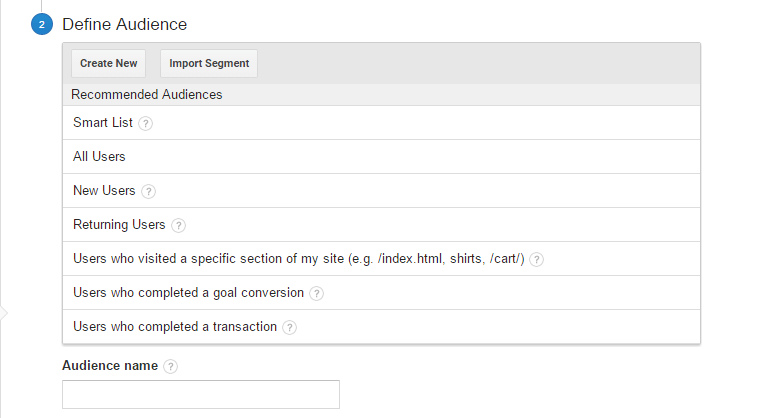Making the Most Of Google Analytics Audiences Within Your Search Campaigns
Search marketers, have you been using Google Analytics in conjunction with Remarketing Lists for Search Ads? If not, columnist Laura Collins is here to explain the benefits.

Since its launch in 2013, Remarketing Lists for Search Ads (RLSA) has become such an integral tool for PPC marketers that it’s hard to remember what our campaigns looked like without them. Did we just… use the same bid for everyone? Madness.
Things got even more exciting in June 2015, when Google announced they were allowing Google Analytics remarketing lists to be used in search campaigns (where they’d previously been restricted to use in display).
As you may know, there are many more options at your disposal when building remarketing lists in Google Analytics (GA) than in AdWords, so this opens up a range of new possibilities for your RLSA activity. But how exactly do you get your GA account ready for RLSA? And with so many options to choose from, how do you decide which lists are right for you?
In this article, I’m going to examine some of the most successful GA + RLSA strategies we’ve implemented at Periscopix, a Merkle Company, and how to go about setting them up.
Getting Started
Before you get carried away with brainstorming strategies and creating GA remarketing lists, you need to make sure that your GA account supports remarketing.
This is a very simple process for anyone with “edit” access to the account: In the admin tab, just navigate to the correct property and click Tracking Info, then Data Collection. Then it’s as simple as flicking a switch to enable data collection for both display and search remarketing.
Once that’s done, you can get started on building your remarketing lists. Much like in AdWords, where remarketing lists are automatically created as soon as your code is implemented on-site, GA offers up some inspiration for audiences you could be targeting.
Under the remarketing tab, you’ll find a selection of preconfigured audiences that can be easily created with just a few clicks. Or if you’ve got some specific audiences in mind, you can choose to create a new audience or import a segment that has already been created within the account.
At Periscopix, we’ve had a few months to try out a range of GA + RLSA strategies, and here are a handful of those that we’ve found to be most successful.
Google Analytics Smart Lists
Smart Lists are one of the handy preconfigured audience types at your disposal in the remarketing tab. They’re lists automatically created by Google based on machine learning and conversion data — which, in theory, should contain users highly likely to convert on a subsequent visit.
There’s already been compelling evidence of the benefits of using these audiences within your display remarketing campaigns, and it seems they’re proving just as successful in search. Some of our clients are seeing GA smart lists achieving conversion rates up to 20 percent higher than other audiences when applied to search campaigns.
But in fact, it’s Shopping campaigns where these audiences are really excelling. Several retail clients have applied smart lists as audiences and seen conversion rates 58 percent higher than their other audiences and 138 percent higher than users outside their remarketing lists.
These strong conversion rates mean cost of sale for smart lists is up to 59 percent lower than overall Shopping performance, meriting the use of some large positive bid adjustments to maximize the revenue from these audiences. With these adjustments only recently put in place, it’ll be fascinating to see the true impact the use of Smart Lists in Shopping will have on performance.
User Engagement Lists
Another very popular strategy when using GA remarketing is to create audiences of your most highly engaged users. While AdWords remarketing lists can be great for retargeting people who’ve visited the site, simply visiting a particular URL may be no real indication of whether someone is the right customer and therefore worth re-targeting.
In particular, this can be a problem for certain industries where you’re battling with an uneducated market. Hosting is a perfect example of this: someone searching for “hosting” could be your next big customer or a teenager looking for a new place to host his next game of Minecraft. If that teenager ends up on your home page and in your “all visitors” list, you certainly don’t want to bid more for next time he completes a similar search.
By creating lists in GA based on user engagement, you can help to filter out those irrelevant users and drill down to the visitors really worth spending extra money on. A few of our most successful engagement-based audiences have been:
- Spent more than X minutes on site
- Visited more than Y pages per session
- Bounces = 0
If you’re not seeing a significantly improved performance from your current audiences, why not go one step deeper and make sure you’re only using those brilliant RLSA strategies for your most engaged users?
Enhanced Ecommerce
Enhanced Ecommerce is a plugin that enables retailers to measure user interactions with particular products on-site. This can be anything in the funnel, from viewing a product on a category page to actually purchasing.
It can provide fascinating insights into how users are behaving, how different products are performing, and also where people are falling out of the sales funnel.
Not only that, it enables you to build remarketing lists based on those interactions. If you’re using Enhanced Ecommerce, a new tab will appear in your Audience Builder, where you can create lists of users who have added a certain brand to their basket, spent over a threshold or purchased a category of product, to name but a few categories.
At Periscopix, we’ve started building remarketing lists using Enhanced Ecommerce for several clients and have big plans for how to utilize them in both display and search.
For one retailer, “Back to School” season is one of their busiest times of year — but with capped budgets and a highly competitive search ad landscape, we couldn’t afford to be in position 1 at all times last summer.
However, in our arsenal for next year are lists of users who have already purchased a school uniform. When summer 2016 arrives, we know we can afford to increase bids for those users, as they’re highly likely to purchase from us again.
Things To Remember
There are so many audiences you can create in GA that simply wouldn’t be possible in AdWords, so it can be difficult to know where to start. I hope this article has provided some inspiration, but there are a couple of things to bear in mind.
First, you can’t use lists based on demographics or interests in search campaigns. Also, each remarketing list you create can only be linked to one AdWords account, so if you’re dealing with a large number of accounts, some logical naming conventions and a bit of patience may be in order.
And if I haven’t given you enough reasons to try out GA + RLSA, then remember that unlike building AdWords remarketing lists, it won’t even entail any changes to your site. Almost any advertiser could start building and using these lists tomorrow. So what are you waiting for?
Contributing authors are invited to create content for Search Engine Land and are chosen for their expertise and contribution to the search community. Our contributors work under the oversight of the editorial staff and contributions are checked for quality and relevance to our readers. The opinions they express are their own.
Related stories
New on Search Engine Land


